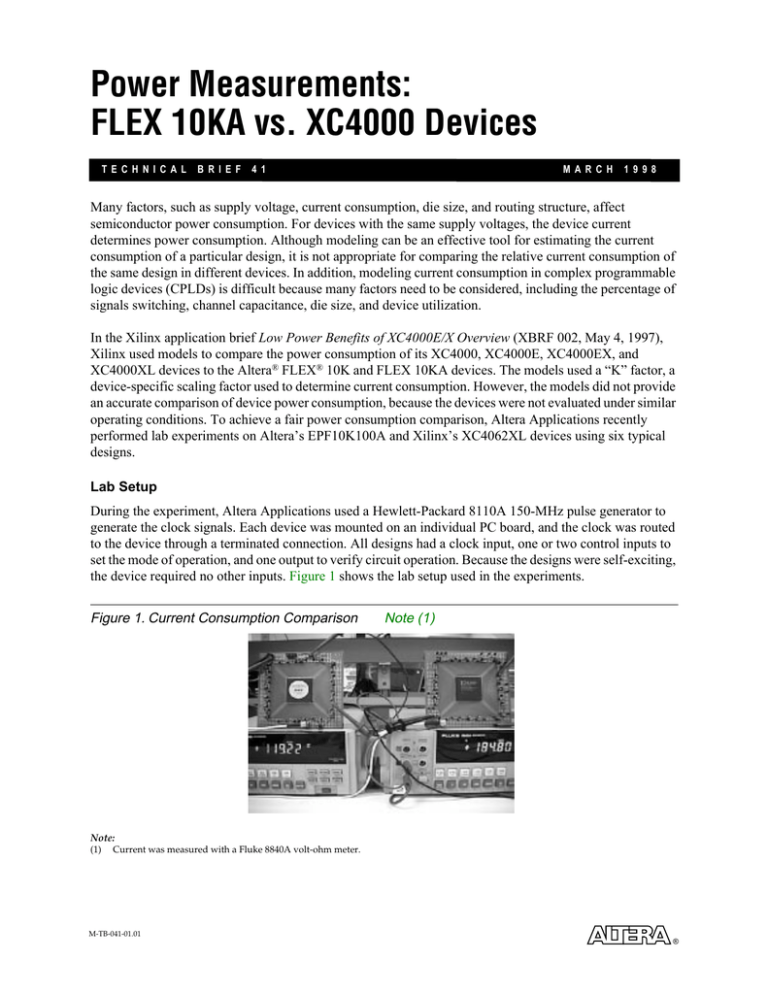
Power Measurements:
FLEX 10KA vs. XC4000 Devices
T E C H N I C A L
B R I E F
4 1
M A R C H
1 9 9 8
Many factors, such as supply voltage, current consumption, die size, and routing structure, affect
semiconductor power consumption. For devices with the same supply voltages, the device current
determines power consumption. Although modeling can be an effective tool for estimating the current
consumption of a particular design, it is not appropriate for comparing the relative current consumption of
the same design in different devices. In addition, modeling current consumption in complex programmable
logic devices (CPLDs) is difficult because many factors need to be considered, including the percentage of
signals switching, channel capacitance, die size, and device utilization.
In the Xilinx application brief Low Power Benefits of XC4000E/X Overview (XBRF 002, May 4, 1997),
Xilinx used models to compare the power consumption of its XC4000, XC4000E, XC4000EX, and
XC4000XL devices to the Altera® FLEX® 10K and FLEX 10KA devices. The models used a “K” factor, a
device-specific scaling factor used to determine current consumption. However, the models did not provide
an accurate comparison of device power consumption, because the devices were not evaluated under similar
operating conditions. To achieve a fair power consumption comparison, Altera Applications recently
performed lab experiments on Altera’s EPF10K100A and Xilinx’s XC4062XL devices using six typical
designs.
Lab Setup
During the experiment, Altera Applications used a Hewlett-Packard 8110A 150-MHz pulse generator to
generate the clock signals. Each device was mounted on an individual PC board, and the clock was routed
to the device through a terminated connection. All designs had a clock input, one or two control inputs to
set the mode of operation, and one output to verify circuit operation. Because the designs were self-exciting,
the device required no other inputs. Figure 1 shows the lab setup used in the experiments.
Figure 1. Current Consumption Comparison
Note (1)
Note:
(1)
Current was measured with a Fluke 8840A volt-ohm meter.
M-TB-041-01.01
®
ALTERA MEGAFUNCTION PARTNERS PROGRAM
Power Consumption Experiments
The Altera EPF10K100A and Xilinx XC4062XL devices were chosen because they have similar densities
and functionality. Designs using RAM and ROM functions were implemented in the FLEX 10KA device’s
embedded array blocks (EABs) and in the XC4062XL device’s configurable logic blocks (CLBs). Table 1
describes the devices used in the experiment.
Table 1. Devices Used in the Experiment
Feature
Device
Altera
Xilinx
EPF10K100ARC240-3
XC4062XLHQ240-3
4,992
4,608
12
0
Logic elements (LEs)
EABs
The first two experiments (i.e., the 14-tap FIR filter and 32 × 32-bit multiplier) represented typical designs
and included both registered and logic functionality that used a high percentage of each device. The other
experiments tested the current consumption of various RAM implementations as well as the global clock
tree. Table 2 details the six designs used in the experiment.
Table 2. Designs Used in the Experiment
EPF10K100A LEs
XC4062XL LEs, Note (1)
14-tap FIR filter (12-bit data)
3,135
3,322
32 × 32-bit multiplier (6-level pipeline)
2,155
2,402
59
234
Designs
256 × 8-bit synchronous RAM
512 × 32-bit synchronous RAM
84
1,476
Device half-full of 16-bit counters
(144 counters)
2,449
2,452
Clock tree (loaded by 3,000 registers)
3,000
3,000
Note:
(1)
One Xilinx CLB is equivalent to two Altera logic elements (LEs).
Figure 2 shows the results of the power consumption experiment.
Figure 2. Power Consumption
600
500
400
ICCA
(mA)
300
EPF10K100A
XC4062XL
200
100
0
512 × 32
16-Bit Clock Tree
14-Tap 32 × 32-Bit 256 × 8
Filter
Multiplier RAM Only RAM Only Counters Note (1)
(20 MHz) (13 MHz) (29 MHz) (20 MHz) (25 MHz) (40 MHz)
Design
Note:
(1)
The clock tree was loaded by 3,000 registers.
The experiment showed that the EPF10K100A device consumed considerably less power than the
XC4062XL device. On average, the EPF10K100A device consumed 28% less current than the XC4062XL
device for logic-only designs (i.e., designs that do not use EABs in FLEX 10KA devices or distributed
RAM in XC4000XL devices).
RAM Power Consumption
In XC4062XL devices, each CLB can be used as a 32 × 1 RAM structure, and larger RAM blocks are built
by combining multiple CLBs. In EPF10K100A devices, RAM is implemented in EABs, which contain
2,048 bits of RAM that can be configured in several configurations with widths up to 8 bits wide. On
average, RAM implemented in FLEX 10KA EABs used 90% less current than RAM implemented in
XC4000XL CLBs (see Figure 3).
Figure 3. RAM Power Consumption
300
250
XC4062XL
200
ICCA
(mA)
150
100
50
EPF10K100A
0
0
5
10
15
20
25
Frequency (MHz)
Clock Tree Power Consumption
The EPF10K100A device consumed less power than the XC4062XL device for several reasons. For
instance, the XC4062XL device had a large clock tree that consumed more power than the EPF10K100A
clock tree (see Figure 4). A global clock tree is a network of buffers and signal lines that are connected to
all of the registers in the device to ensure that all destinations receive signal transitions simultaneously. In
the experiments, the EPF10K100A clock tree consumed 42% less power than the XC4062XL clock tree.
Figure 4. Clock Tree Power Consumption
300
XC4062XL
250
200
ICCA
(mA)
150
EPF10K100A
100
50
0
0
20
40
60
Frequency (MHz)
The clock tree power consumption is directly affected by the size of a clock tree, which, in turn, is directly
related to the device’s die size. The die of the XC4062XL device is 1.9 times larger than that of the
EPF10K100A device (see Figure 5). Therefore, the XC4062XL clock tree consumes more power than the
EPF10K100A clock tree.
Figure 5. Die Size Comparison
Altera EPF10K100A
Relative Die Size = 1
0.35-µm Process
4,992 LEs, 12 EABs
Xilinx XC4062XL
Relative Die Size = 1.9
0.35-µm Process
4,608 LEs, 0 EABs
Continuous Routing & Segmented Routing
There are several possible reasons why Altera EPF10K100A devices consume less power than Xilinx
XC4000XL devices. The most significant reason is the device interconnect structure. EPF10K100A devices
use a continuous interconnect routing structure that is better suited for interconnect routing than the pass
transistors used in XC4062XL devices. To demonstrate this difference, model the pass transistors and metal
lines as parallel-plate capacitors. The following equation shows that power is linearly related to capacitance
(C), voltage (V), and voltage switching.
dv
P = Cv -----dt
Because both devices have similar voltage switching characteristics and operate at a 3.3-V core voltage, the
capacitance will be a major factor in determining which interconnect structure consumes more power.
A
C ∼ ----T
The equation above shows that for equivalent unit areas (A = 1), the device with the thicker insulator (T)
has less capacitance. The thickness of the XC4062XL pass-gate oxide is about 100 Å versus about 10,000 Å
for the EPF10K100A metal line. Thus, EPF10K100A devices have less capacitance and consume less
power.
Revision History
The information contained in Technical Brief 41 (Power Measurements: FLEX 10KA vs. XC4000 Devices)
version 1.01 supersedes information published in Technical Brief 41 (Power Measurements: FLEX 10KA
vs. XC4000 Devices) version 1.
Technical Brief 41 (Power Measurements: FLEX 10KA vs. XC4000 Devices) version 1.01 contains
corrected information on the number of bits per EAB in “RAM Power Consumption” on page 3.
4
Altera Corporation
References
The following documents provide more detailed information. Part numbers are shown in parentheses.
■
■
■
FLEX 10K Embedded Programmable Logic Family Data Sheet, available in the 1998 Data Book
(A-DB-0198-01)
AN 74: Evaluating Power in Altera Devices, available in the 1998 Data Book (A-DB-0198-01)
TB 23: FLEX 10K Power Consumption (M-TB-023-02)
You can obtain these document from:
■
■
■
Altera Literature Services at (888) 3-ALTERA
Altera web site at http://www.altera.com
Your local Altera sales representative
Copyright 1998 Altera Corporation. Altera, FLEX, FLEX 10K, FLEX 10KA, EPF10K100, and EPF10K100A are trademarks and/or service
marks of Altera Corporation in the United States and/or other countries. Other brands or products are trademarks of their respective holders.
All rights reserved.
®




